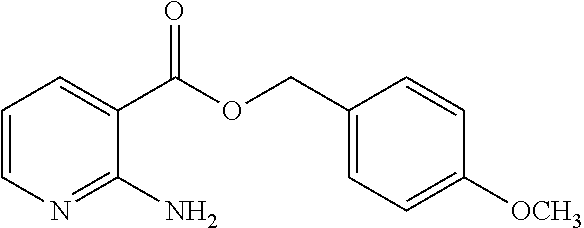2-aminonicotinic acid ester derivative and bactericide containing same as active ingredient
a technology ester derivative, which is applied in the field of aminotinic acid ester derivative and bactericide containing the same as an active ingredient, can solve the problems of increasing the difficulty of resistance to pathogenic bacteria, reducing the frequency of application, and reducing the spectrum of residual activities and the like, so as to achieve excellent effects
- Summary
- Abstract
- Description
- Claims
- Application Information
AI Technical Summary
Benefits of technology
Problems solved by technology
Method used
Image
Examples
example 1
Synthesis of 2-phenoxybenzyl 2-aminonicotinate
[0081]0.200 g of 2-phenoxybenzylalcohol, 0.230 g of 1-ethyl-3-(3-dimethylaminopropyl)carbodiimide hydrochloride and 0.146 g of 4-dimethylaminopyridine were added to a solution of 0.138 g of 2-aminonicotinic acid in methylene chloride, and the mixture was heated under reflux for 3 hours. After cooled to room temperature, the mixture was extracted with methylene chloride, and the aqueous layer was further extracted with methylene chloride. The organic layers were combined and dried over anhydrous sodium sulfate. After concentration under reduced pressure, the resulting residue was purified by silica gel column chromatography to yield 0.180 g of Compound No. 1, as an oil, which is described in Table 1 below. In addition, further compounds of the present invention were synthesized in a similar manner. Table 1 below shows the compounds of the present invention which were produced in a similar manner to Example 1.
TABLE 1[I] Compound No. R...
preparation example 1
Emulsifiable Concentrate
[0089]A compound of the present invention (10 parts), xylene (60 parts), N-methyl-2-pyrrolidone (20 parts) and Sorpol 3005X (a mixture of a nonionic surfactant and an anionic surfactant, TOHO Chemical Industry Co., Ltd., Japan, a trade name) (10 parts) were mixed and dissolved uniformly to give an emulsufible concentrate.
preparation example 2
[0090]The compound of the present invention (20 parts), Nipsil NS-K (white carbon, Tosoh Silica Corporation, Japan, a trade name) (20 parts), Kaolin Clay (kaolinite, TAKEHARA KAGAKU KOGYO CO., LTD., Japan, a trade name) (70 parts), Sanx P-252 (sodium lignosulfonate, NIPPON PAPER INDUSTRIES CHEMICAL Div., Japan, a trade name) (5 parts) and Runox P-65L (an alkylarylsulfonate, TOHO Chemical Industry Co., Ltd., Japan, a trade name) (5 parts) were mixed and ground uniformly by means of an air mill to give a wettable powder.
PUM
 Login to View More
Login to View More Abstract
Description
Claims
Application Information
 Login to View More
Login to View More - R&D
- Intellectual Property
- Life Sciences
- Materials
- Tech Scout
- Unparalleled Data Quality
- Higher Quality Content
- 60% Fewer Hallucinations
Browse by: Latest US Patents, China's latest patents, Technical Efficacy Thesaurus, Application Domain, Technology Topic, Popular Technical Reports.
© 2025 PatSnap. All rights reserved.Legal|Privacy policy|Modern Slavery Act Transparency Statement|Sitemap|About US| Contact US: help@patsnap.com



